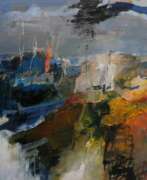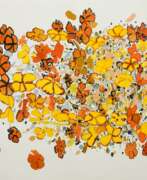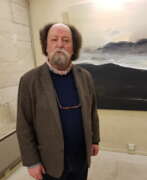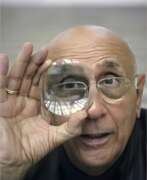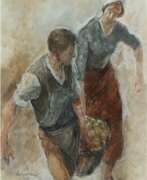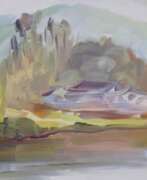Landscape painters 21st century


Alexander Grigorievich Maksymenko (Russian: Александр Григорьевич Максименко) was a Soviet and Ukrainian painter of the second half of the twentieth and early twenty-first centuries. He is known as a painter, graphic artist, watercolorist, and art historian.
Alexander Maksymenko worked in the genres of still life, landscape, portrait, as well as in genre painting. His genre works cover themes of collective farm life, including "Masters of the Land" and "Innovators of Collective Farm Fields". For the latter work he received the Stalin Prize. The master actively participated in exhibitions in Ukraine and abroad. His works are in the National Art Museum of Ukraine, the Museum of the History of Ukraine in World War II, as well as in other art museums and private collections.


Sultan Shamsutdinovich Abaev (Russian: Султан Шамсутдинович Абаев), a Chechen and Russian artist born on November 1, 1954, in Khaidarkan, Soviet Union, is celebrated for his distinctive contributions to landscape art. A member of the Artists Unions of Saint Petersburg and the Chechen Republic, Abaev's work exemplifies his profound connection to his cultural roots and the rich landscapes that inspire him.
Educated at the prestigious Repin Institute of Painting, Sculpture, and Architecture in Saint Petersburg, Abaev has been honored multiple times for his artistic achievements, including receiving the title of Honored Artist of the Russian Federation. His works have been internationally recognized, finding places in private collections across countries such as Germany, the United States, and Japan.
Abaev's career also includes time spent abroad in Sri Lanka and South Korea from 1991 to 1993, where he expanded his artistic horizons and produced a series of paintings influenced by these experiences. Today, his works are sought after by collectors, especially those interested in landscapes and cultural narratives embedded in art.
Stay updated on exhibitions and sales related to Sultan Shamsutdinovich Abaev's enchanting landscapes by signing up for our exclusive alerts. These updates are essential for collectors and art connoisseurs interested in owning a piece of Chechen and Russian art history.


Mikhail Georgievich Abakumov (Russian: Михаил Георгиевич Абакумов) was a Russian artist, celebrated for his diverse artistic contributions and his deep connection to his homeland, Kolomna. Born in 1948, Abakumov became a prominent figure in the Russian art scene, recognized as a People's Artist of Russia and a dedicated teacher and community leader in Kolomna.
Abakumov's artistic oeuvre includes industrial and genre canvases, evocative landscapes, and intimate portraits, which are held in high esteem across Russia and in private collections worldwide. Notable works like "Metallurg" (1974) and "Spring Morning" (1996) showcase his ability to capture the essence of Russian life and landscapes. His art has been exhibited extensively within Russia and internationally, including over thirty solo exhibitions since 1979, contributing significantly to the cultural tapestry of the Soviet and post-Soviet periods.
His works are part of prestigious collections, including the State Tretyakov Gallery, and have been featured in various museums across cities like Moscow, St. Petersburg, and internationally.
For those interested in exploring Russian art and the legacy of Mikhail Georgievich Abakumov, signing up for updates on exhibitions and sales of his artworks can provide valuable insights and opportunities. Join our community to stay informed about events and auctions featuring Abakumov's remarkable works.




Victor Ashotovich Abramyan (Russian: Виктор Ашотович Абрамян) was a Soviet and Russian artist of the second half of the twentieth and early twenty-first centuries. He is known as a painter, a representative of the Leningrad school.
Victor Abramyan created portraits, landscapes, still lifes and genre paintings. He participated in exhibitions from the early 1970s in Leningrad. Among his famous works are "Blockade everyday life", "Still Life with a Centennial", "Leningrad. 1942. Women on Guard in the besieged city", "Young Guests" and others.
Abramyan's works are in museums and private collections in Russia and many other countries.


Angelo Accardi is a contemporary Italian artist. He grew up surrounded by both modern and traditional art. Although he studied fine art at the Art Academy of Naples, he never completed his training. Angelo Accardi illustrates surreal visions of everyday life under realistic backdrops of urban and natural landscapes. There is never a single meaning, but a whole story behind each painting. Ironic, striking, and playful, Accardi’s unique perspective and avant-garde style is a result of his diverse inspirations.


John Ronald Craigie Aitchison was a Scottish painter. He was best known for his many paintings of the Crucifixion, one of which hangs behind the altar in the chapter house of Liverpool Cathedral, Italian landscapes, and portraits (mainly of black men, or of dogs). His simple style with bright, childlike colours defied description, and was compared to the Scottish Colourists, primitivists or naive artists, although Brian Sewell dismissed him as "a painter of too considered trifles".
His career-long fascination with the crucifixion was triggered by a visit to see Salvador Dalí's Christ of St John of the Cross in 1951 after it was acquired by the Kelvingrove Gallery.


Vladimir Ivanovich Akulov (Russian: Владимир Иванович Акулов) is a Soviet and contemporary Belarusian artist. He is known as a painter, graphic artist and teacher, a representative of the second wave of Belarusian avant-garde.
Vladimir Akulov in his work has developed a unique style under the influence of expressionism, cubism, primitivism, fauvism. He is a master of portrait, landscape, still life, compositions with symbolic and allegorical subjects, illustrations of literary works. During his career the artist created several cycles of portraits, including those of famous people.


Saad Al-Tai is a contemporary Iraqi artist. He participated in several exhibitions in Baghdad and abroad. Al-Tai was a member of the Iraqi Impressionists Group. Despite the name of the group, Al-Tai was not categorically an impressionist, rather his style lent more towards cubist realism. For him, the colour of the painting was determined by its subject matter. Al-Tai is an award winning artist who, amongst other things, received Italian knighthood in 2005 in recognition for his efforts in fostering Iraqi-Italian cultural dialogue including founding and heading the Italian Language Department in 2002 at the College of Languages, Baghdad University.


Peter Alexander was an American artist who was part of the Light and Space artistic movement in southern California in the 1960s. He is notable for his resin sculptures from the 1960s and 1970s. He studied architecture in England before receiving both his BFA and MFA from the University of California, Los Angeles. Alexander started as an architect, before developing a reputation in the 1960s for creating his sculptures.


Darren James Almond is an English artist, based in London. He was nominated for the 2005 Turner Prize. He works in a variety of media including photography and film, which he uses to explore the effects of time on the individual.[3] He uses "sculpture, film and photography to produce work that harnesses the symbolic and emotional potential of objects, places and situations, producing works which have universal as well as personal resonances"
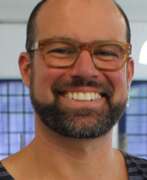

Luis M. Alonzo-Barkigia is a contemporary Mexican artist. He studied at the Malmö Academy of Art (Sweden) and at the University of Illinois at Chicago. He was awarded the UIC Presidential Fellowship, the Larsen Fellowship for Studio Arts.
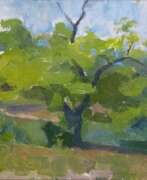



Evgenia Petrovna Antipova (Russian: Евгения Петровна Антипова) was a notable Russian painter, graphic artist, and art teacher. She stood out for her genre compositions, portraits, landscapes, and still lifes, primarily utilizing oils and watercolors. Evgenia Antipova's works often depicted apple orchards and Crimean landscapes, showcasing her profound connection to nature and her ability to capture its essence.
Evgenia Antipova's education at the prestigious Repin Institute of Arts shaped her artistic journey, leading to a career enriched with personal exhibitions and a significant presence in the art community. Not only did her artworks gain recognition in Russia, but they also found their way into international collections and exhibitions, notably in France, Germany, the United States, and the United Kingdom.
Throughout her career,Evgenia Antipova was an active participant in various significant exhibitions, displaying her works alongside other renowned artists. Her contributions to the art world were recognized with personal exhibitions in Saint Petersburg and inclusion in art auctions and exhibitions abroad.
Evgenia Antipova's paintings are part of prestigious collections, including the State Russian Museum, and continue to be celebrated in art museums and private collections globally. Her legacy as a prominent figure in the Leningrad School of painting endures, captivating art enthusiasts and collectors with her vivid and emotionally resonant works.
For those interested in Russian art, particularly the Leningrad School of painting, Evgenia Petrovna Antipova's oeuvre offers a rich exploration of genre compositions and landscapes, reflecting the artistic vibrancy of her era. Collectors and art experts are encouraged to delve into her works and consider signing up for updates on exhibitions and sales featuring her paintings.


Ugo Attardi was an Italian painter, sculptor and writer. Attardi moved from Genoa to Rome in the early 1950s, where he formed the group Forma 1 together with other artists. His sculpture of Ulysses is now permanently installed in Battery Park in New York


Gerhard Ausborn was a German painter. He studied painting at the Hamburg University of Fine Arts.
Landscapes, ancient sites and modern cities characterise the subject of Gerhard Ausborn's paintings. In parallel, he creates abstract compositions without objects.
The paintings are inspired by impressions the artist gathered during his numerous journeys to many countries around the world. The paintings were not created on location, but always afterwards in his Hamburg studio. They are not intended to be an exact copy of reality, but rather, in memory, what is seen is reduced to the essentials and combined with the artist's own ideas, sensations and experiences.


John Baeder is an American painter closely associated with the photorealist movement. He is best known for his detailed paintings of American roadside diners and eateries. His interest in small towns across America began when he was young by photographing old cars and other relics. He started working as an art director in Atlanta for a branch of a New York advertising agency in 1960, and subsequently moved to New York City in 1964. He went on to have a successful career in advertising through the early 1970s, while continuing to paint, draw and photograph on his own time. Baeder left the advertising field in 1972 to pursue his artistic career full-time. The same year, OK Harris Gallery in New York began exhibiting his artworks. Since then, he has had more than thirty solo exhibitions at art galleries. His work includes oil paintings, watercolors and photographs. Baeder’s work aims to chronicle the disappearing aspects of American culture. Baeder is the recipient of the Tennessee Governor's Distinguished Artist Award in 2009.


Irina Mikhailovna Baldina (Russian: Ирина Михайловна Балдина) was a Soviet and Russian artist of the second half of the twentieth and early twenty-first centuries. She is known as a painter, a representative of the Leningrad school.
Irina Baldina participated in exhibitions in Leningrad since 1952. Her work covered a variety of genres, including portraits, landscapes, still lifes and genre compositions. From 1960 to 1980, her works were characterized by themes of modernity, nature and people of Zaonezhye. Her style was characterized by broad brushstrokes, decorative and mastery in conveying the colors of northern nature.
Her works are in museums and private collections all over the world, including Russia, France, USA, Japan and other countries.


Lewis "Duke" Baltz was an American visual artist, photographer, and educator. He was an important figure in the New Topographics movement of the late 1970s. His best known work was monochrome photography of suburban landscapes and industrial parks which highlighted his commentary of void within the "American Dream". His work is focused on searching for beauty in desolation and destruction. Baltz's images describe the architecture of the human landscape: offices, factories and parking lots. His pictures are the reflection of control, power, and influenced by and over human beings. His books and exhibitions, his "topographic work", such as The New Industrial Parks, Nevada, San Quentin Point, Candlestick Point, expose the crisis of technology and define both objectivity and the role of the artist in photographs. He wrote for many journals, and contributed regularly to L'Architecture d'Aujourd'hui. Baltz's work is held in the collections of the Solomon R. Guggenheim Museum, Metropolitan Museum of Art, Tate Modern, Los Angeles County Museum of Art, Whitney Museum of American Art etc.


Issa Abasovich Barkhanoyev (Russian: Исса Абасович Барханоев) was a Soviet and Russian Ingush artist of the last quarter of the twentieth and early twenty-first centuries. He is known as a painter, draughtsman, landscape painter, genre painter and poet, a self-taught artist.
Issa Barkhanoyev created more than 500 paintings during his career, in which, according to critics, he skillfully conveyed his deep thoughts and feelings through images and symbols, and these works of art epitomize spirituality and life philosophy. The works of the folk artist are in museums of the Republic of Ingushetia and private collections.


Mike Bayne is a contemporary Canadian artist creates miniature Photorealist paintings of overlooked North American scenes, frequently of his childhood town. Capturing every detail from his working photographs, he replicates his subject not only in terms of imagery, but often also in scale, by mimicking the size of actual commercially printed photographs. His depictions of architecture and vehicles render environments locked in a moment of time, devoid of people and movement. Visually, his works are at once abruptly realistic, and yet purposefully inorganic. He received his MFA from Concordia University and has participated in many group shows across the U.S. and Canada. His work is in the collection of the National Gallery of Canada, the Art Gallery of Ontario, the Nerman Museum etc. Bayne was also the recipient of the Kingston Prize for Portraiture in 2011.


Peter Hill Beard was an American artist, photographer, diarist, and writer who lived and worked in New York City, Montauk and Kenya. His photographs of Africa, African animals and the journals that often integrated his photographs, have been widely shown and published since the 1960s.




Arne Besser is a contemporary American artist. He received training as an artist at the Art Center School, Los Angeles. There he studied with John Audubon Tyler and Lorser Feidelsson. Beser’s approach to Photo-Realism is to draw from the urban landscape and nature a succinct “set like” image of reality. His city scenes depict New York street life alive with trading and traders, prostitutes and junkies looking for a fix. These visual images iconify the underside of urban life in a way that elevates this point of view to an almost mythic level.




Otmar Blaser is a contemporary German artist. In 1967 he studied at the Werkkunstschule with Prof. Holweck. In 1968 he traveled through Europe, the Middle East, Canada and America. From 1970-1976 he studied at the University of the Arts in Berlin. In 1975 he was a master's student with Professor Bachmann, in 1976 he was an assistant to Professor Kapitsky at the Institute of Visual Communication and Design. In 1977 he was a lecturer at the Volkshochschule Berlin-Neukölln, collaborating freelance with the Theatertreffen Berlin.


Francois Boisrond is a contemporary French painter. He studied from 1977 to 1980 at the National School of decorative Arts. In 1981 he became involved in the Free Figuration movement. Inspired by visual products (advertising products, posters, stickers, video games etc.), cartoon characters, and by using acrylic paint, Francois Boisrond’s works are colourful, figurative and enigmatic, and his simplified shapes are often outlined in black. He portrays mainly characters, frequently symbolic in everyday situations, but he also depicts urban, maritime or rural landscapes. Besides this Boisrond creates humanitarian and publicity posters. Since the 1990’s the artist has become interested in an imaginary public and the everyday life that invades each and every one of us.
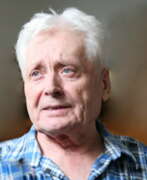

Vasily Pavlovich Borisenkov (Russian: Василий Павлович Борисенков) was a Soviet and Russian artist of the second half of the twentieth and early twenty-first centuries. He is known as a painter and teacher, a representative of the Leningrad school of painting.
Vasily Borisenkov actively participated in Leningrad art exhibitions since 1954, was the author of genre and battle paintings, landscapes and portraits. Among his famous works are the paintings "Difficult Conversation", "Spring", "Strelna. The Beginning of Summer" and many others. The master's works are in museums and private collections both in Russia and abroad.


André Bourrié, full name André Georges Jules Louis Bourrié, was a French painter.
He was known for his city and seascapes, which used oil paint, sometimes mixed with chalk and sand to create a textural effect on the canvas.
Bourrier's work has been exhibited in galleries and museums around the world, including the Centre Pompidou in Paris and the Galleria Bohemia in New York.
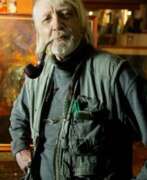

David Fielding Gough Boyd was an Australian artist, and a member of the Boyd artistic dynasty.
In 1946, he worked with his brother Guy at the Martin Boyd Pottery in Sydney. He also established a pottery studio in London in the early 1950s and continued working mainly in pottery through to the mid-1960s. In 1956, Boyd and his wife became widely known as leading Australian potters. They introduced new glazing techniques and potter's wheel use in shaping sculptural figures.
Boyd's painting career began in 1957 with a series of symbolic paintings on Australian explorers that aroused much controversy at the time, focusing as they did on the tragic history of the Aboriginal Tasmanians. In 1958 he exhibited a series of paintings based on the histological episodes in the explorations of Burke and wills and Bass and Flinders.[3] He joined the Antipodeans Group in the 1950s. Boyd discovered a technique in 1966 that he named Sfumato, after da Vinci's usage of the word to describe graduations of smoky tones in painting. Boyd's method achieved this effect through a new technique involving candle flame.


Eduard Georgievich Bragovsky (Russian: Эдуард Георгиевич Браговский) was a Soviet and Russian artist of the second half of the twentieth and early twenty-first centuries. He is known as a painter who specialized in the genres of landscape, portrait and still life.
Eduard Bragovsky closely connected his creative destiny with the Russian town of Tarusa, where he lived for several years. He painted many paintings, creating a "portrait" of the town. The artist actively traveled around the country, creating works from nature. His works were exhibited in various museums in Russia, the CIS and other countries, as well as at personal exhibitions in different parts of the world.
He actively participated in the work of the Moscow Union of Artists, was a member of the Board, headed the painting section.


Herbert Brandl is one of the most famous Austrian expressionist artists. He achieved success through his large-format works.
Landscape as a theme was always dominant in his work, where pictorial abstraction and subjectivity alternate. Since the beginning of the new millennium, Brandl's passion for the monumentality of mountain landscapes has become increasingly evident. Using various formats and techniques, the artist has reinterpreted the theme of mountains, playing with expressive gestures, abstract colour spaces and massive forms.




Gary Bunt is a British self-taught artist known for his paintings of the English suburbs and countryside. He took up art to overcome a serious illness. Gary Bunt in a primitive style, with sophisticated simplicity and good humor depicts ordinary life with its simple joys.


Volker Bußmann is a contemporary German artist known for his diverse and eclectic body of work. He explores various artistic genres, including landscape and figure painting, op-art, and printmaking. His artistry demonstrates a wide range of influences and styles, making him a versatile and dynamic artist. Bußmann's work may incorporate a combination of traditional and contemporary elements.


Zlata Nikolaevna Byzova (Russian: Злата Николаевна Бызова) was a Soviet and Russian artist of the second half of the twentieth and early twenty-first centuries. She is known as a painter, a representative of the Leningrad school, famous for her genre compositions, portraits, landscapes and studies from life.
Zlata Byzova achieved particular success in provincial portrait-types and Old Ladoga sketches of the 1960s-1970s. Her works were successfully presented at exhibitions and auctions of Russian painting in France in 1989-1992.
The artist's works are in museums and private collections in Russia, Finland, Germany, France and other countries.


Thomas Calloway Lea III was an American muralist, illustrator, painter, war correspondent, writer and historian. Much of his fiction and literary work has focused on Texas, north-central Mexico, and his World War II experiences in the South Pacific and Asia. Two of his most popular novels, The Brave Bulls and The Wonderful Country, are considered classics of Southwestern American literature.
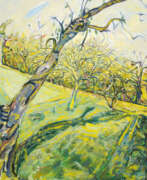

Bernard Chaet was an American artist. Chaet is known for his colorful, dynamic modernist paintings and masterful draftsmanship, his association with the Boston Expressionists, and his 40-year career as a Professor of Painting at Yale University. His works also include watercolors and prints. In 1994, he was named a National Academician by the National Academy of Design. Chaet's works are in the permanent collections of many important museums. Chaet is known for his association as a first generation Boston Expressionist. Having studied with Zerbe, a father of Boston Expressionism, Chaet's early works certainly adhere to the techniques and philosophy of the school.


Tom Christopher is an American painter known for his New York City urban paintings and murals. Most of the work is painted using small-batch, handmade acrylic paint. Pencil lines from the initial exploratory sketch stage often remain on the white canvass. His typical images include cabbies, delivery men, skylines, and chaotic city scenes. His work is usually done with acrylic paint in an expressionist style. Christopher began as a commercial artist, and has become a painter with worldwide galleries and exhibitions. He has also experimented with collage-style paintings and silkscreens that utilize multiple images and layers.




Christian Clerebout is a French contemporary artist. He spent his childhood in Africa, which has left an indelible imprint in his painting style. He studied art from 1966 until 1979 in Paris and Rome. Before settling indefinitely in Brittany, he ran away to North America, lured by the United States, and New York, in particular. This is where his powerful cityscapes evolved: engorged with sweeping movement, brilliant colors and intense darks and lights. He has expanded creatively to include such subject matters as orchestras, airports, elephants and financial themes, but his expressive style is always recognizable.


Ann Craven is a contemporary American painter known for her lush depictions of the moon, birds, and multi-colored stripes. Craven’s use of serial motifs belies her interest in ephemeral moments, seasonal cycles, and the changeable qualities of painting. She received her BFA from the Massachusetts College of Art in 1986 and her MFA from Columbia University in 1993. She notably served as an artist assistant to Alex Katz, whose work influenced her own. Much of Craven’s practice revolves around painting en plein air, in this way she has captured the moon on hundreds of nights over the years. The artist currently lives and works in New York. Today, her works are held in the collections of the Whitney Museum of American Art in New York, the Museum of Contemporary Art in Chicago, and the Institute of Contemporary Art in Miami, among others.


Ulrike Crespo is a German photographer, psychologist and philanthropist. She grew up in Darmstadt and, after training as a hotel manager, studied French, art history and archeology in Lausanne and Geneva. In 1980 she moved to Frankfurt am Main and taught German for foreigners there. From 1985 to 1990 she studied psychology and, having received a license to practice medicine, worked as a psychotherapist, and then in the psychosomatic department of the university clinic of the Johann Wolfgang Goethe University. In 1995 she opened her own practice. In 1998, as a co-heir of Wella, she founded the Crespo Chamber Music Foundation, in 2004 she founded another foundation, the Crespo Foundation, which promotes educational projects. Donated most of the proceeds from the sale of the family-owned Wella Group. With her funds, she supports people who are in unfavorable starting conditions, but want to build their own career.


Ray Austin Crooke was an Australian artist known for for serene views of Islander people and ocean landscapes, many of which are based on the art of Paul Gauguin. He won the Archibald Prize in 1969 with a portrait of George Johnston. His painting The Offering (1971) is in the Vatican Museum collection. Many of his works are in Australian galleries. He was made a Member of the Order of Australia in the 1993 Australia Day Honours, "in recognition of service to the arts, particularly as a landscape artist".


Robert Henry Dickerson was an Australian figurative painter and former member of the Antipodeans group of artists. Dickerson is one of Australia's most recognised figurative artists and one of a generation of influential artists who include Ray Crooke, Charles Blackman, Laurence Hope, Margaret Olley and Inge King. Dickerson was a self-taught artist who refused to go to art school. His art has been described as angular and high contrast chiaroscuro and executed in a range of materials including paint, pastels, charcoals and other graphic media. The inspiration for his art came from everyday life and he drew on the themes of loneliness, vulnerability and isolation. Lone characters with long noses and whimsical, often averted eyes featured heavily of his work.


Georg Dinz is a contemporary Austrian artist. After studying at the Vienna University of Applied Arts, Dienz lives and works as a room and stage designer in the Viennese punk scene. Shortly after the fall of the Wall, Dienz moves to Berlin, where he takes part in various art projects in the wild post-reunification period. Today he concentrates on free painting in his studio in the former Berlin artist district of Prenzlauer Berg. Georg Dienz's works are stylistically characterized by a flat and clear application of paint and can be described as "reduced realism".


Randy Dudley is a photorealist painter working both in New York City and in the Midwest. He spends many hours to achieve work that looks exactly like a photograph, visual reality. Dudley's goal is to challeng the viewer to look at something for the first time, to see the beauty and vistas of scenes often hurriedly passed by such as a canal, a river, or a water view. Dudley's works can be found in the collections of the Metropolitan Museum and the Brooklyn Museums in New York.


Don Eddy is a contemporary representational painter. He gained recognition in American art around 1970 amid a group of artists that critics and dealers identified as Photorealists or Hyperrealists, based on their work's high degree of verisimilitude and use of photography as a resource material. Eddy has worked in cycles, which treat various imagery from different formal and conceptual viewpoints, moving from detailed, formal images of automobile sections and storefront window displays in the 1970s to perceptually challenging mash-ups of still lifes and figurative/landscapes scenes in the 1980s to mysterious multi-panel paintings in his latter career. Eddy's work has been informed by wide-ranging, sometimes contradictory influences: old masters (e.g., van Eyck and Vermeer), Impressionist and Neo-Impressionist color, the analytical cubism of Braque and Picasso, Hans Hofmann, Conceptual and Minimalist critiques of Abstract Expressionism, and Pop art.






Rainer Fetting is a German painter and sculptor.
Rainer Fetting was one of the co-founders and main protagonists of the Galerie am Moritzplatz in Berlin, founded in the late 1970s by a group of young artists (mainly painters) from the class of Karl Horst Hödicke at the former Berliner Hochschule für Bildende Künste (Berlin Art Academy, today known as Universität der Künste). Fetting is now one of the internationally best known contemporary German artists, having created a large oeuvre of expressive figurative paintings covering many different kinds of subject-matter, as well as many bronze sculptures.


LaToya Ruby Frazier is an American visual artist, renowned for her profound work that delves into social justice, cultural change, and the American experience. Born in 1982 in Braddock, Pennsylvania, Frazier utilizes various media, including photography, video, and performance, to explore themes of industrialism, environmental justice, and human rights. Her art, deeply rooted in collaborative storytelling, often portrays her family and community, offering a lens into the lived experiences of working-class families amid societal and environmental challenges.
Her notable series "The Notion of Family" explores her family's life in Braddock, revealing the impacts of industrial decline on the community and environment. This work not only highlights LaToya Ruby Frazier's personal narrative but also serves as a broader commentary on race, class, and the American industrial landscape. Her commitment to social documentation is further exemplified in projects like "Flint is Family," where she immersed herself in Flint, Michigan, to document the water crisis's impact on local families.
LaToya Ruby Frazier's exhibitions span across prestigious venues in the US and Europe, reflecting her influence and recognition in the art world. Her works are part of esteemed collections like The Museum of Modern Art and the Whitney Museum of American Art in New York. Frazier's accolades include a MacArthur Fellowship, demonstrating her significant contributions to contemporary art and social activism.
For art collectors and experts, Frazier's work offers a compelling intersection of art, activism, and storytelling, providing insightful perspectives on pressing social issues through the lens of personal and community narratives.
To stay informed about LaToya Ruby Frazier's work and related updates, including new product sales and auction events, subscribing to updates is a valuable opportunity for enthusiasts and collectors alike to engage with her impactful artistry and advocacy.






Azat Khaizovich Galimov is a contemporary Russian artist. Graduated from the Leningrad Higher School of Industrial Art named after V. Mukhina. Currently lives and works in St. Petersburg, a member of the Union of Artists of Russia, a member of the Petrovsky Academy of Sciences and Arts, a member of the Bulgarian Union of Artists. In 2007 he was included in the catalog "The Best Artists of Russia". An adherent of the realistic school of painting. Lots and lots of work. Makes numerous sketches and writes studies, traveling to different countries. He is especially good at urban landscapes. His works are in museums and private collections in different countries.
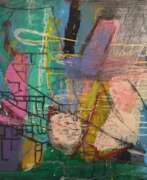

Victor Isaakovich Gershman (Russian: Виктор Исаакович Гершман) was a Soviet and Russian artist of the twentieth and twenty-first centuries. He is known as a painter and nonconformist graphic artist.
Victor Gershman began his artistic career early - already at the age of 14 his drawings were exhibited at the International Exhibition of Children's Drawings. He participated in the Second World War, after demobilization and graduation from the Institute he worked at textile mills, but also devoted time to creativity. He traveled a lot, painting landscapes, architecture, still lifes. The artist mastered various techniques - watercolor, ink, pencil, oil, collage. In the 1960s and 1970s he became interested in non-traditional and abstract painting.


Frauke Gloyer is a contemporary German artist. She studied freehand painting at the University of Fine Arts in Braunschweig. She has been working as a freelance artist since 1988.
Frauke Gloyer's work includes expressionist landscapes, still lifes, portraits and animal studies.




April Gornik is an American artist who paints American landscapes. Her realist yet dreamlike paintings and drawings embody oppositions and speak to America's historically conflicted relationship with nature. While she doesn't categorize herself as an environmental artist, she is a passionate supporter of environmental causes.












































